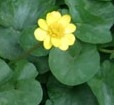 This attractive herbaceous perennial native to Europe and western Asia was introduced to North America and is considered invasive in many areas. It likes disturbed, moist soil and shady conditions but adapts to various conditions and grows on forest floors as well as construction sites where it can form a dense mat that chokes out native or garden plants.
This attractive herbaceous perennial native to Europe and western Asia was introduced to North America and is considered invasive in many areas. It likes disturbed, moist soil and shady conditions but adapts to various conditions and grows on forest floors as well as construction sites where it can form a dense mat that chokes out native or garden plants.
Description
One of the earliest plants to emerge in spring, lesser celandine forms a rosette of leaves up two to six inches tall. The dark green leaves are fleshy, heart-shaped and usually patterned. The flowers appear singly on slender stalks in the spring and usually have eight to ten glossy bright yellow petals. Plants spread by seed and by small bulbils produced at the base of the stalks. Although the leaves die back after blooming, the bulbils remain alive in the soil.
Control
The focus of control is the bulbils that remain underground until spring. Remove plants by digging well below the roots so that the bulbils are not left behind to produce more plants. Destroy the dug plants and do not be tempted to add them to the compost pile.
In extreme cases, lesser celandine can be treated with an herbicide containing glyphosate in late winter or early spring as soon as new growth appears. The plants are tough and more than one treatment may be necessary to control the problem.